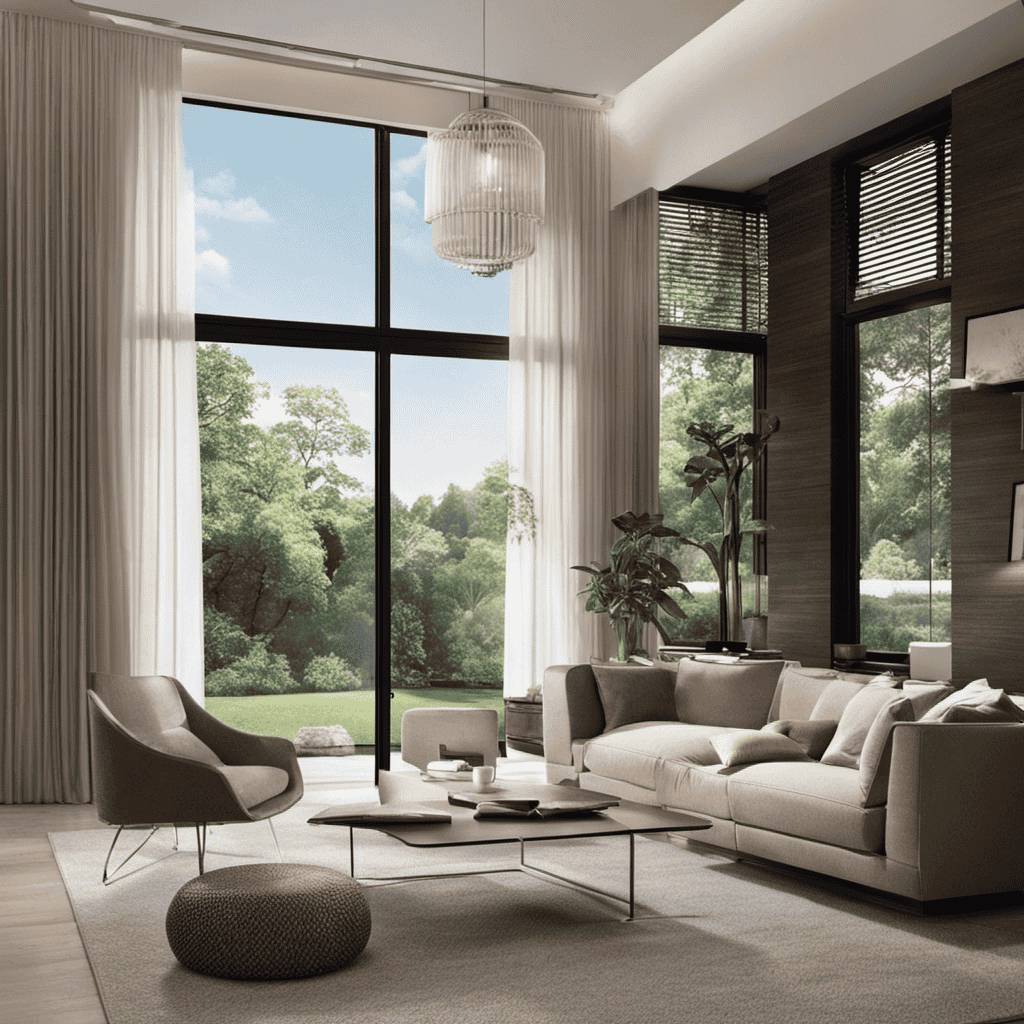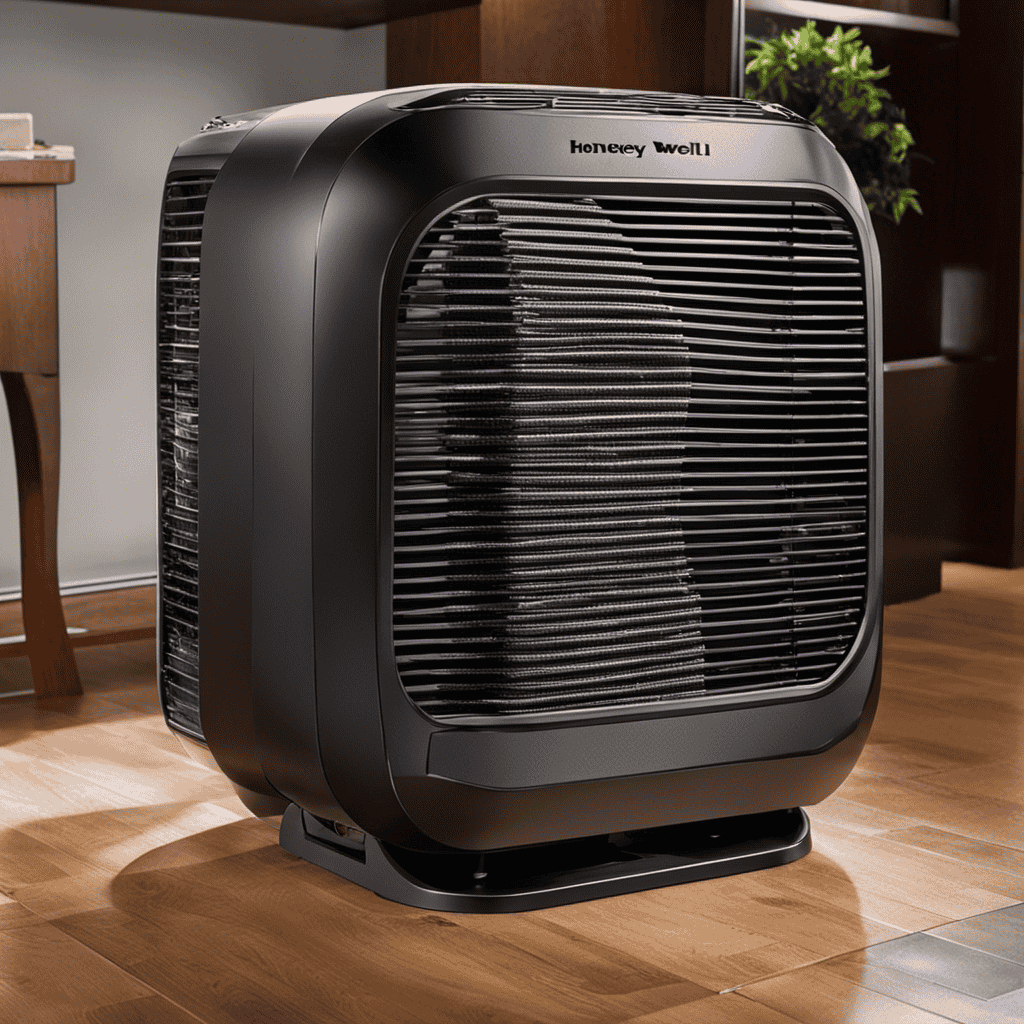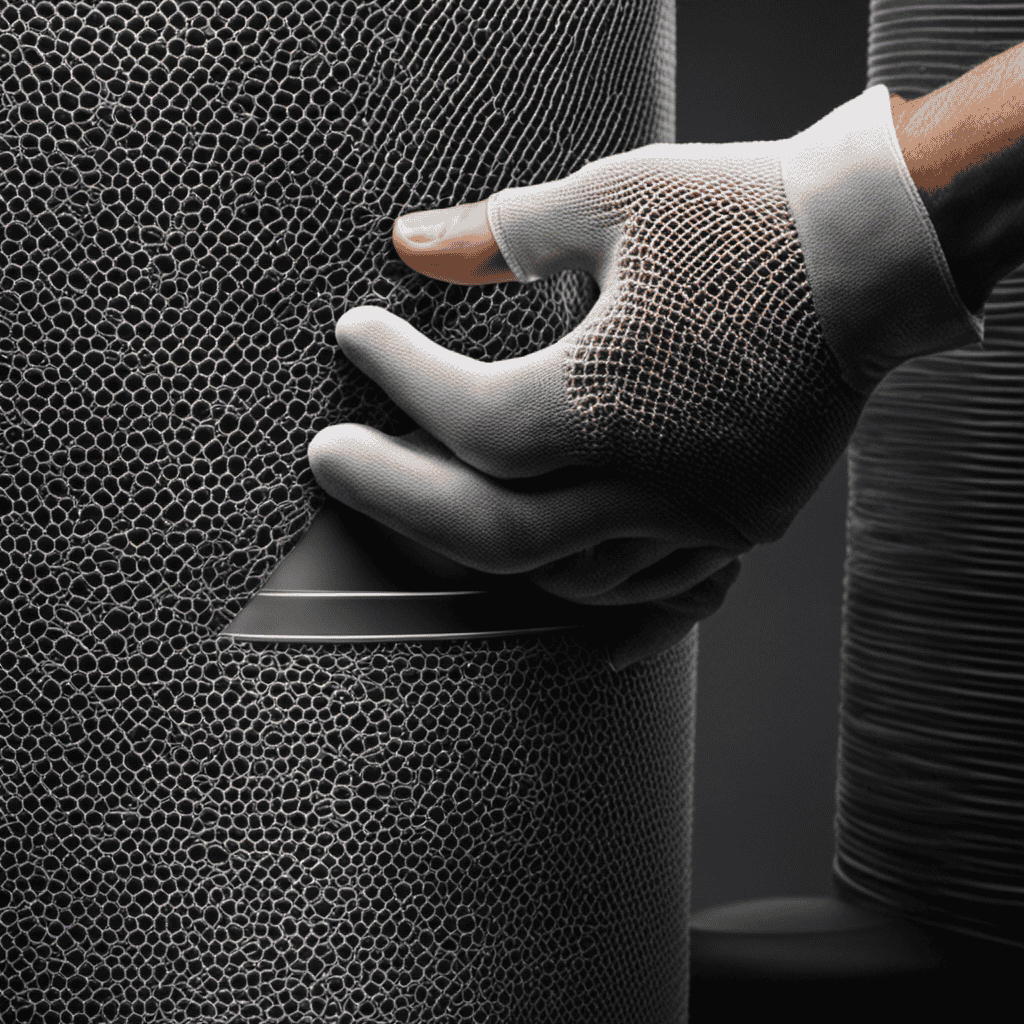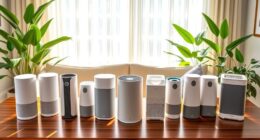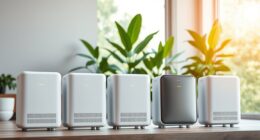Here’s a secret tip: achieving clean and fresh air in your home depends on where you position your air purifier. It’s more than just placing it randomly, believe me.
In this article, I’ll guide you through the ins and outs of finding the best location for your air purifier. From bedrooms to living rooms, kitchens to home gyms, we’ll explore how to optimize air circulation and avoid common pitfalls.
So, let’s dive in and uncover the secrets of optimal air purification placement.
Key Takeaways
- Placing an air purifier in different rooms can remove allergens, reduce pollutants, improve air quality, and enhance sleep quality.
- When determining the best location for an air purifier, consider air circulation, proximity to pollution sources, and the overall layout of the space.
- Optimal air circulation and avoiding obstructions are important for better intake and distribution of air, capturing more pollutants, and reducing maintenance needs.
- Proximity to pollution sources is crucial, with recommended distances for kitchen and smoking areas, industrial emissions, and traffic.
Benefits of Placing an Air Purifier in Your Bedroom
Placing an air purifier in your bedroom can greatly improve the quality of the air you breathe while you sleep. The health benefits of having an air purifier in your bedroom are numerous.
First and foremost, it helps to remove allergens such as dust, pollen, and pet dander from the air, which can alleviate symptoms for those suffering from allergies or asthma. Additionally, air purifiers can help to reduce the presence of harmful pollutants such as volatile organic compounds (VOCs) and indoor air pollutants that may be present in your bedroom.
The optimal placement for an air purifier in your bedroom is near the area where you sleep, preferably a few feet away from your head. This ensures that the air you breathe while sleeping is clean and fresh.
Transitioning into the next section, let’s discuss how to determine the best location for your air purifier.
How to Determine the Best Location for Your Air Purifier
When determining the best location for your air purifier, there are several key factors to consider.
First, optimal air circulation is crucial to ensure the effectiveness of the purifier. It’s important to avoid placing the purifier in corners or obstructed areas, as this can impede airflow and hinder the purifier’s ability to clean the air.
Next, proximity to pollution sources should be taken into account. Placing the purifier closer to these sources can help target and remove pollutants more efficiently.
Lastly, it’s important to consider the overall layout of the space. The purifier should be placed in an area where it can cover the entire room or space effectively.
Optimal Air Circulation
To ensure optimal air circulation, you should position the air purifier in an area with good airflow. This is crucial for the effective operation of the purifier and to maximize its benefits.
Air purifiers work by filtering and circulating the air in a room, removing pollutants and improving indoor air quality. By placing the purifier in an area with good airflow, such as near a window or a doorway, you allow for better intake and distribution of air. This helps the purifier to capture more pollutants and distribute clean air throughout the space.
Additionally, positioning the air purifier in an area with good airflow can also help prevent the accumulation of dust and debris on the filters, reducing the need for frequent maintenance and ensuring the longevity of the device.
Avoiding Obstructions or Corners
Make sure you don’t position your air purifier near any obstructions or corners as this can hinder its ability to effectively circulate and filter the air in the room.
Proper air circulation is crucial for maximizing the efficiency of your air purifier and improving indoor air quality.
When determining the ideal location for your air purifier, consider the size of the room and the sources of pollution.
In the bedroom, placing the air purifier near the bed can provide numerous health benefits, such as reducing allergies and improving sleep quality.
In the living room, kitchen, and home office, consider the factors of air circulation, kitchen air pollution, cooking odors, and electronic devices’ impact.
For nurseries, large open spaces, and basements, prioritize pet-friendly considerations, odor control, and noise reactions.
In high traffic areas and home gyms, ensure proper air circulation to combat pollutants.
Smoker considerations should involve placing the purifier near the source and optimizing multiple purifiers for larger spaces.
Proximity to Pollution Sources
If you’re near sources of pollution, consider placing the air purifier closer to them for better filtration. By doing so, you can effectively target and remove the pollutants at their source, improving the air quality in your immediate surroundings. To help you understand the impact of air purifier placement, here is a table showcasing the recommended proximity to different pollution sources:
| Pollution Source | Recommended Proximity |
|---|---|
| Kitchen | 1-2 meters |
| Smoking Area | 1-2 meters |
| Industrial Emissions | 3-5 meters |
| Traffic | 5-7 meters |
The Importance of Proper Air Circulation When Placing an Air Purifier
When it comes to optimizing the efficiency of an air purifier, proper placement is key. The position of the air purifier within a room can greatly affect its ability to effectively circulate and filter the air.
Additionally, the placement of the air purifier can have a significant impact on the overall air quality in the space, as it determines how effectively it can capture and remove pollutants.
Lastly, the size of the room should also be taken into consideration when determining the placement of an air purifier, as larger rooms may require multiple units or strategic placement to ensure adequate coverage.
Optimal Placement for Efficiency
To optimize the efficiency of your air purifier, you should place it in a central location within the room. This ensures that the air purifier can effectively circulate and filter the air in all areas of the room.
When considering the placement of your air purifier, it is important to take into account any potential obstructions that may hinder its performance. Keep the air purifier away from furniture, curtains, and other objects that could block the airflow.
Additionally, consider the proximity to pollution sources such as windows, doors, and areas where smoking or cooking occurs. Placing the air purifier near these sources will help capture and remove pollutants more efficiently.
Impact on Air Quality
For better air quality, you can consider placing the air purifier in areas where there is a high concentration of pollutants.
Indoor air pollution can be a serious health concern, as it can contain harmful particles such as dust, pollen, pet dander, and even volatile organic compounds (VOCs).
Air purifiers work by filtering out these contaminants, improving the overall air quality in your home or office.
The placement of the air purifier is crucial for its effectiveness. It is recommended to place the purifier in rooms where you spend the most time, such as the bedroom or living room.
Additionally, positioning the air purifier near potential sources of pollution, such as cooking areas or pet areas, can further enhance its efficiency in removing harmful particles from the air.
Considerations for Room Size
Placing the air purifier in a room that is too large may reduce its effectiveness. When considering the size of the room, it’s important to take into account the air purifier’s coverage area. Here are some key factors to consider:
-
Room size: Ensure that the air purifier is suitable for the dimensions of the room. A larger room may require a higher CADR (Clean Air Delivery Rate) to effectively clean the air.
-
Pet-friendly areas: If you have pets in your home, placing the air purifier in areas where they spend the most time can help reduce pet dander and odors.
-
Home gym: If you have a home gym, it’s recommended to place the air purifier nearby to filter out dust particles and odors generated during workouts.
Considering these factors will help you optimize the effectiveness of your air purifier and ensure cleaner air in your living space.
Considerations for Placing an Air Purifier in Your Living Room
When placing an air purifier in your living room, it’s important to consider factors such as air circulation and size of the room. Optimal air flow is crucial for the effective operation of an air purifier. Placing it in a central location in the room ensures that the purified air can circulate evenly throughout the space. Additionally, consider the size of the room when choosing the appropriate air purifier. A larger room may require a more powerful model to effectively clean the air. Maintenance requirements should also be taken into account. Regular cleaning and filter replacements are necessary to ensure the optimal performance and longevity of the air purifier. Refer to the table below for a summary of the key considerations for placing an air purifier in your living room:
| Consideration | Importance |
|---|---|
| Air circulation | High |
| Room size | Medium |
| Maintenance requirements | High |
Why You Should Place an Air Purifier in Your Kitchen
When it comes to air quality, the kitchen is often overlooked, but it can be a major source of indoor air pollution. Cooking activities can release a range of pollutants, including volatile organic compounds (VOCs) and particulate matter, which can contribute to poor air quality and potential health risks.
Kitchen Air Pollution
If you’re concerned about kitchen air pollution, you should consider placing the air purifier near the stove and other cooking areas. Cooking fumes can release harmful pollutants into the air, such as carbon monoxide, nitrogen dioxide, and volatile organic compounds (VOCs). These pollutants can lead to respiratory issues and other health problems.
To effectively reduce kitchen air pollution, here are some ventilation options to consider:
- Install a range hood with an exhaust fan to capture and remove cooking fumes directly from the source.
- Use a window fan to create cross ventilation, allowing fresh air to enter and pollutants to exit.
- Consider using a portable air purifier specifically designed for kitchens, which can capture and filter cooking fumes and other airborne particles.
Cooking Odors and Contaminants
To effectively reduce cooking odors and contaminants in your kitchen, consider using a range hood with an exhaust fan. This will capture and remove fumes directly from the source. Cooking odors can be unpleasant and linger in the air, while indoor pollutants released during cooking can have detrimental effects on indoor air quality.
By installing a range hood with an exhaust fan, you can effectively eliminate these issues. The exhaust fan works by drawing the cooking fumes and odors out of the kitchen and expelling them outside. This not only improves the air quality in your kitchen but also prevents the spread of cooking odors throughout your home.
Additionally, it helps to remove indoor pollutants, such as carbon monoxide and volatile organic compounds, which can be harmful to your health. So, when it comes to reducing cooking odors and indoor pollutants, a range hood with an exhaust fan is a wise choice.
Health Benefits of Purification?
You can reap numerous health benefits by incorporating a purification system into your home. The air we breathe plays a crucial role in our overall well-being, and improving its quality can have a significant impact on our health.
Here are some key health benefits of air quality improvement:
-
Reduces respiratory issues: A purification system can remove allergens, dust, and pollutants from the air, reducing the risk of respiratory problems like asthma and allergies.
-
Enhances sleep quality: By removing airborne irritants and pollutants, a purification system creates a cleaner and healthier sleeping environment, resulting in better sleep quality.
-
Boosts immune system: Clean air helps strengthen our immune system, making us more resistant to infections and diseases.
Investing in a purification system can greatly improve the air quality in your home, leading to a range of health benefits. So why not take a step towards a healthier lifestyle today?
The Ideal Placement of an Air Purifier in Your Home Office
Consider placing your air purifier in a central location within your home office to ensure optimal air filtration.
The ideal placement of an air purifier in a home office is crucial for maximizing its effectiveness in removing airborne pollutants and improving indoor air quality. By positioning the air purifier in a central location, it can efficiently circulate and filter the air throughout the entire room. This placement allows the purifier to capture pollutants emitted from electronic devices, furniture, and other sources commonly found in a home office.
Additionally, it ensures that the purified air reaches you directly, reducing the risk of inhaling harmful particles.
Now, let’s explore the factors to consider when placing an air purifier in a nursery or child’s room.
Factors to Consider When Placing an Air Purifier in a Nursery or Child’s Room
When placing an air purifier in a nursery or child’s room, it’s important to be mindful of potential safety hazards. Ensuring optimal air circulation and minimizing proximity to pollution sources are crucial factors to consider.
Here are some key points to keep in mind:
-
Positioning: Place the air purifier in a central location to maximize air circulation within the room.
-
Distance from Pollution Sources: Keep the air purifier away from potential sources of pollution, such as smoking areas, fireplaces, or kitchen vents.
-
Safety Features: Choose an air purifier with childproof features, such as a lockable control panel or a grill with small openings, to prevent accidents.
How to Effectively Place an Air Purifier in a Large Open Space
To effectively place an air purifier in a large open space, it’s important to strategically position it to maximize its coverage and effectiveness. Optimal placement depends on the size of the air purifier and the layout of the space. Consider the following table for guidance:
| Air Purifier Size | Optimal Placement |
|---|---|
| Small | Near the source of pollutants |
| Medium | In the center of the room |
| Large | In a corner or against a wall |
By placing a small air purifier near the source of pollutants, such as a smoking area or kitchen, it can effectively capture and filter the air. A medium-sized air purifier should be positioned in the center of the room to ensure proper air circulation. For large air purifiers, placing them in a corner or against a wall can help create a "clean air zone" by directing the airflow towards the center of the room.
With the optimal placement of air purifiers in large open spaces, the benefits of placing an air purifier in your basement can also be maximized.
The Benefits of Placing an Air Purifier in Your Basement
Placing an air purifier in your basement can greatly improve the air quality and reduce the presence of allergens and pollutants. This has a significant impact on health, as poor indoor air quality can contribute to respiratory issues, allergies, and other health problems.
The benefits of purification in the basement include:
-
Removal of mold spores: Basements are often prone to dampness and high humidity, creating an ideal environment for mold growth. An air purifier can effectively capture and eliminate mold spores, reducing the risk of respiratory infections and allergic reactions.
-
Reduction of radon gas: Radon is a radioactive gas that can seep into homes through the basement. Prolonged exposure to high levels of radon can increase the risk of lung cancer. An air purifier with a specialized filter can help remove radon gas particles from the air.
-
Elimination of musty odors: Basements can have a musty smell due to high humidity and lack of ventilation. An air purifier can help eliminate these odors, creating a more pleasant and healthier living environment.
Considerations for Placing an Air Purifier in a Pet-Friendly Area
When it comes to placing an air purifier in a pet-friendly area, there are several key considerations to keep in mind.
First, the proximity of the air purifier to the pets can greatly affect its effectiveness in removing pet dander and allergens from the air. It is recommended to place the purifier in close proximity to the pets’ living areas for optimal results.
Additionally, noise levels emitted by the purifier can potentially cause stress or anxiety in some pets. Therefore, it is important to choose a purifier that operates quietly and monitor the pet’s reactions to ensure their comfort.
Pet Proximity and Effectiveness
If you have pets, make sure to place the air purifier in close proximity to them for maximum effectiveness. Pets can contribute to indoor air pollution through shedding fur, dander, and even odor.
By placing the air purifier near your pets, you can capture these pollutants more efficiently and improve the overall air quality in your home. Additionally, proximity to your pets can help address specific pet-related issues, such as controlling pet odors or reducing allergens that may trigger allergic reactions.
However, it is essential to consider pet behavior when placing the air purifier. Some pets may be curious and may tamper with the device, so ensure it is in a safe location.
Lastly, don’t forget to regularly replace the air purifier’s filters to maintain its effectiveness in capturing pet-related pollutants.
Noise and Pet Reactions
To minimize noise-related stress for your pets, consider locating the air purifier in a quiet area of your home. Pets can be sensitive to loud noises, and a noisy air purifier can cause additional stress and anxiety for them. This is especially important if your pet suffers from allergies, as stress can worsen their symptoms.
By placing the air purifier in a quiet area, you can provide a peaceful environment for your pets while still benefiting from the purifier’s ability to reduce pet allergens in the air. Additionally, choosing a purifier with a noise reduction feature can further help to minimize noise-related stress for your furry friends.
Placement for Odor Control
Locating the air purifier in the area where odors are most concentrated can help control and reduce unpleasant smells in your home. By strategically placing the air purifier, you can maximize its effectiveness in eliminating odors. Here are some tips for optimal placement:
- Place the air purifier near the source of the odor, such as the kitchen or bathroom, to target specific areas.
- Ensure that the air purifier is not obstructed by furniture or walls, as this can hinder its ability to circulate and clean the air.
- Consider placing the air purifier in a central location, such as the living room, to allow it to filter and purify the air throughout your home.
The benefits of air purification are numerous. Not only does it remove unpleasant smells, but it also helps reduce allergens, pollutants, and harmful particles in the air.
To maintain the efficiency of your air purifier, regular cleaning and filter replacement are essential. Follow the manufacturer’s instructions for proper maintenance to ensure optimal performance and longevity.
Why You Should Place an Air Purifier Near High-Traffic Areas
Consider placing your air purifier near high-traffic areas to ensure maximum effectiveness in filtering out pollutants and allergens. Proximity to allergens can have a significant impact on respiratory health, as exposure to these substances can trigger allergies and exacerbate respiratory conditions. By placing the air purifier near high-traffic areas, such as entrances or hallways, you can target the areas where pollutants and allergens are most likely to be present. This strategic placement allows the air purifier to capture and remove these harmful particles before they have a chance to circulate throughout your home. To illustrate the benefits of placing an air purifier near high-traffic areas, consider the following table:
| Benefits of Placing Air Purifier Near High-Traffic Areas |
|---|
| Reduces exposure to allergens and pollutants |
| Improves indoor air quality |
| Minimizes respiratory symptoms |
| Enhances overall respiratory health |
The Impact of Placing an Air Purifier Near Electronic Devices
Placing an air purifier near electronic devices can have a significant impact on their performance. As an electronics enthusiast, I have witnessed firsthand how interference from air purifiers can disrupt the functioning of electronic devices. Here are a few reasons why it is crucial to consider the placement of your air purifier in relation to your electronic devices:
-
Electromagnetic Interference: Air purifiers emit electromagnetic waves as they operate, which can interfere with the delicate circuitry of electronic devices.
-
Reduced Signal Strength: The presence of an air purifier near electronic devices can weaken wireless signals, such as Wi-Fi or Bluetooth, making it harder for them to communicate effectively.
-
Overheating: Some air purifiers generate heat during operation. Placing them too close to electronic devices can contribute to overheating, potentially causing damage.
To ensure optimal performance and longevity of your electronic devices, it is vital to consider the placement of your air purifier and minimize any potential interference.
The Best Location for an Air Purifier in a Home Gym or Workout Area
Having an air purifier in my home gym or workout area is essential for maintaining clean and fresh air during my exercise sessions. When it comes to placing the air purifier, optimal air circulation and avoiding obstructions are key factors to consider.
It is recommended to place the air purifier in a location that allows for proper air flow throughout the entire space. This means avoiding placing it in a corner or behind large objects that could obstruct the airflow. Instead, a central location in the room, away from walls and furniture, is ideal.
Additionally, placing the air purifier at a height of about 3-5 feet off the ground ensures that it effectively captures airborne pollutants, such as dust and allergens, that tend to settle closer to the floor.
Considerations for Placing an Air Purifier in a Home With Smokers
It’s important to find a strategic location for an air purifier in a home with smokers to effectively remove harmful smoke particles from the air. By placing the air purifier in close proximity to smoking areas, you can target the source of smoke and minimize its impact on air quality throughout the house.
Here are three key considerations for placing an air purifier in a home with smokers:
-
Position the air purifier in the same room as the smokers to maximize its effectiveness in capturing smoke particles directly from the source.
-
Place the air purifier in a central location within the house to ensure that it can circulate and clean the air in all areas, reducing the spread of smoke particles.
-
Consider using multiple air purifiers strategically placed in different rooms to provide comprehensive coverage and ensure optimal air quality throughout the entire home.
How to Optimize the Placement of Multiple Air Purifiers in Your Home
To optimize the placement of multiple air purifiers in your home, consider strategically positioning them in different rooms to ensure comprehensive coverage and improved air quality throughout. By placing air purifiers strategically, you can target specific areas where allergens and pollutants are most likely to be present. For instance, placing an air purifier in the bedroom can help reduce allergens that may disrupt sleep and worsen allergies. In the living room, where most family members spend a significant amount of time, an air purifier can help remove airborne particles that can trigger asthma symptoms.
To give you a better understanding of the benefits of air purifiers for allergies and asthma, take a look at the table below:
| Room | Allergies | Asthma |
|---|---|---|
| Bedroom | Reduce allergens | Improve sleep |
| Living Room | Remove particles | Reduce symptoms |
| Home Office | Eliminate dust | Enhance focus |
| Kitchen | Remove odors | Improve air quality |
| Nursery | Reduce allergens | Promote healthy air |
Incorporating air purifiers in these rooms can have significant positive impacts on allergies and asthma, providing relief and improving overall respiratory health.
Is There a Specific Location in the House Where an Air Purifier Should Be Placed for Maximum Effectiveness?
When considering the placement of air purifiers, it is important to choose a location where it can effectively circulate the air. Ideal spots include the bedroom for better sleep quality, the living room for shared spaces, and near sources of pollution like the kitchen. Proper placement can maximize the purifier’s effectiveness.
Frequently Asked Questions
Can I Place an Air Purifier in My Bathroom?
Yes, you can place an air purifier in your bathroom. It will help remove pollutants and improve air quality. However, keep in mind that regular maintenance, such as filter replacement, is crucial for optimal performance and longevity.
What Is the Ideal Placement for an Air Purifier in a Laundry Room?
The ideal positioning for an air purifier in a laundry room is near the source of odors, such as the washing machine or dryer. This helps to remove contaminants and improve indoor air quality, creating a healthier environment.
Should I Place an Air Purifier Near a Fireplace or Wood-Burning Stove?
I should not place an air purifier near a fireplace or wood-burning stove. The heat and smoke can damage the purifier. Additionally, it may not effectively filter out allergens or pet dander in that location.
Can I Put an Air Purifier Near a Window or Door?
Putting an air purifier near a window or door can be beneficial, as it helps filter out outdoor pollutants. When choosing an air purifier, consider factors like the size of the room and specific air quality needs.
Is It Recommended to Place an Air Purifier in a Garage or Workshop?
I recommend placing an air purifier in a garage or workshop to improve air quality. It will help remove dust, chemicals, and odors. Position it in a central location for optimal coverage and ensure proper maintenance for best results.
Conclusion
In conclusion, placing an air purifier in your home is like having a guardian angel for your health. It silently and diligently works to cleanse the air you breathe, symbolizing the protection and care it provides.
With strategic placement in your bedroom, living room, kitchen, and even workout area, you can ensure clean and fresh air in every corner of your home.
Let the air purifier be the beacon of purity, guiding you towards a healthier and happier life. Trust in its power and embrace the comfort it brings.
